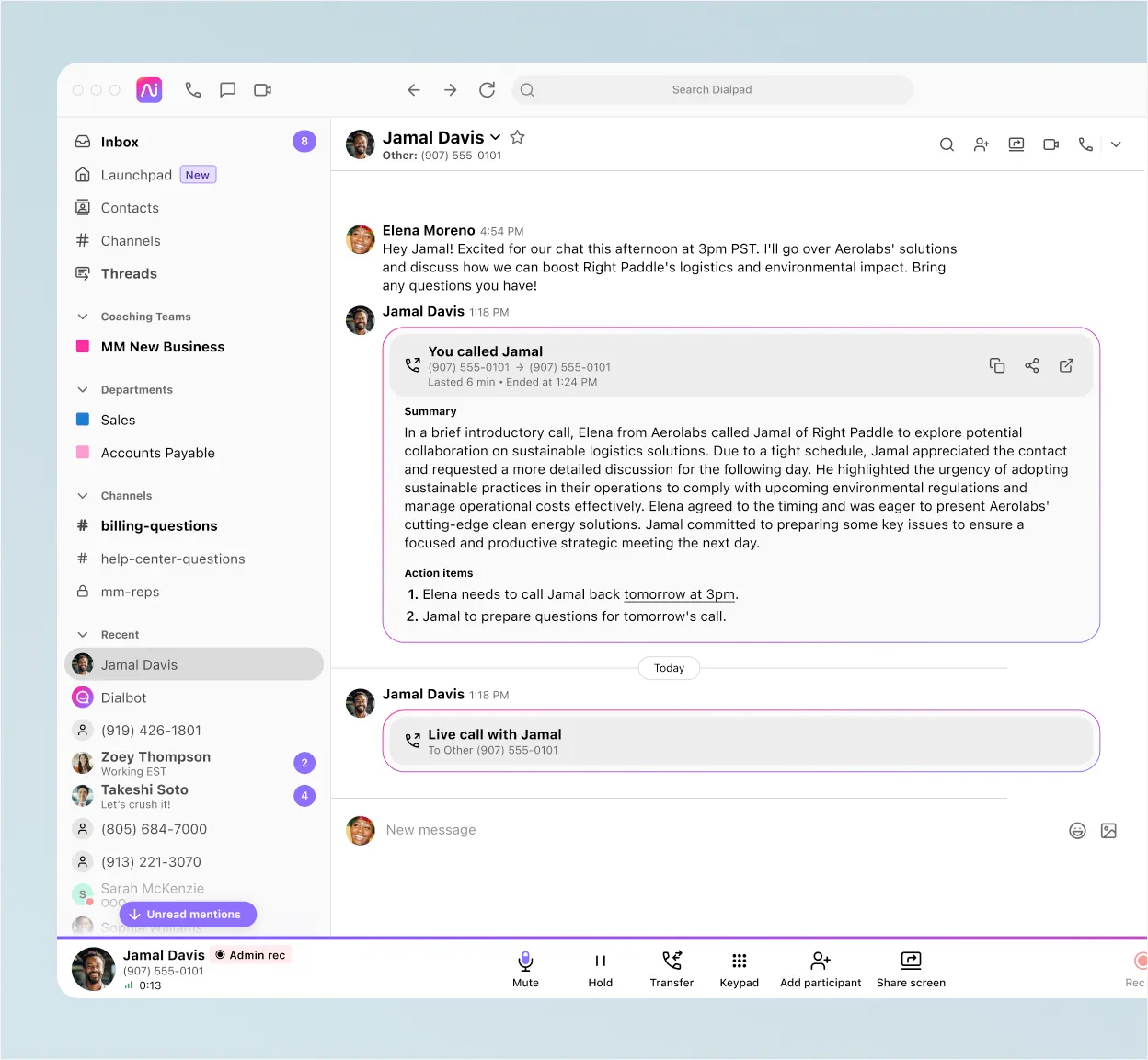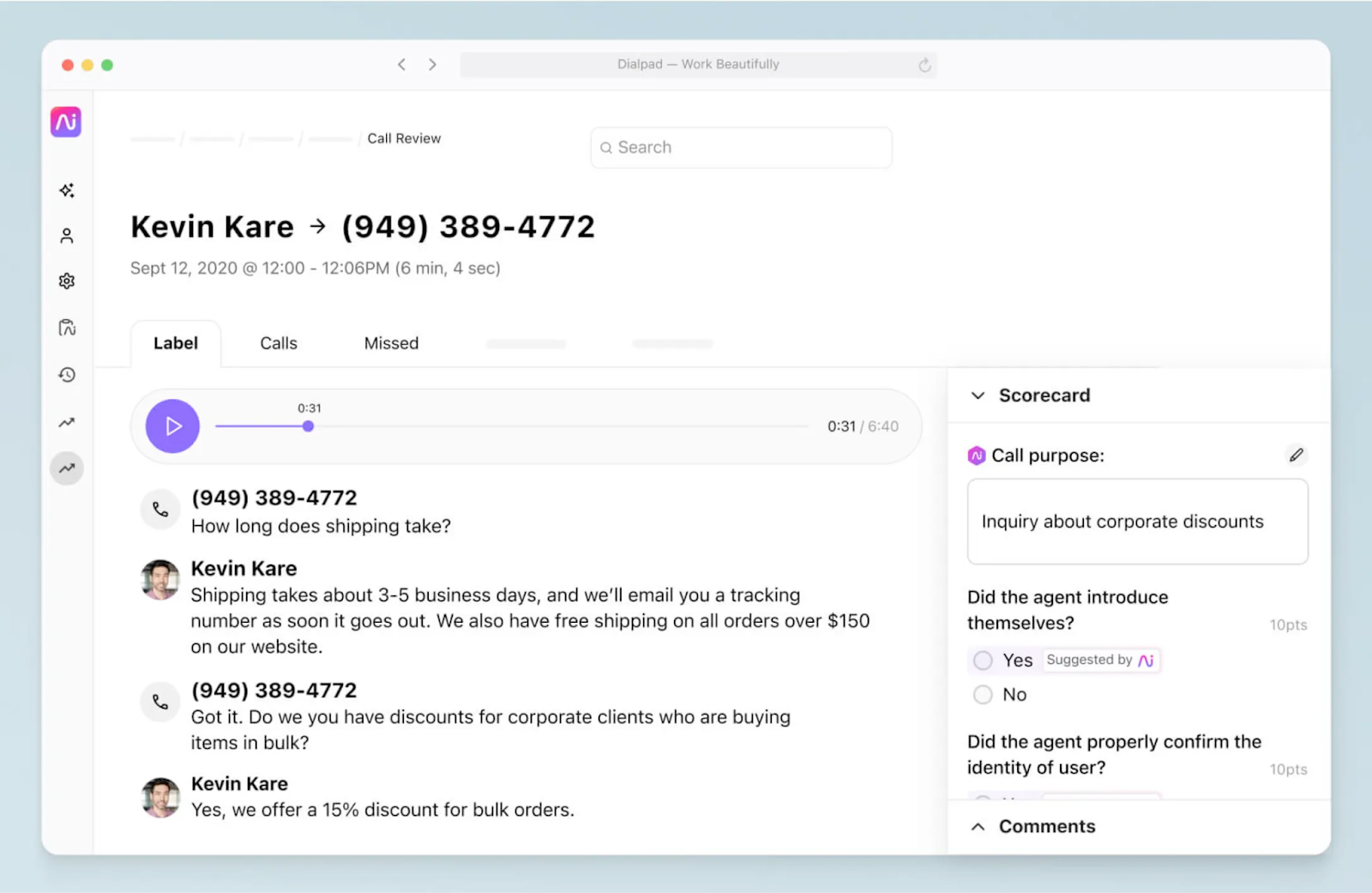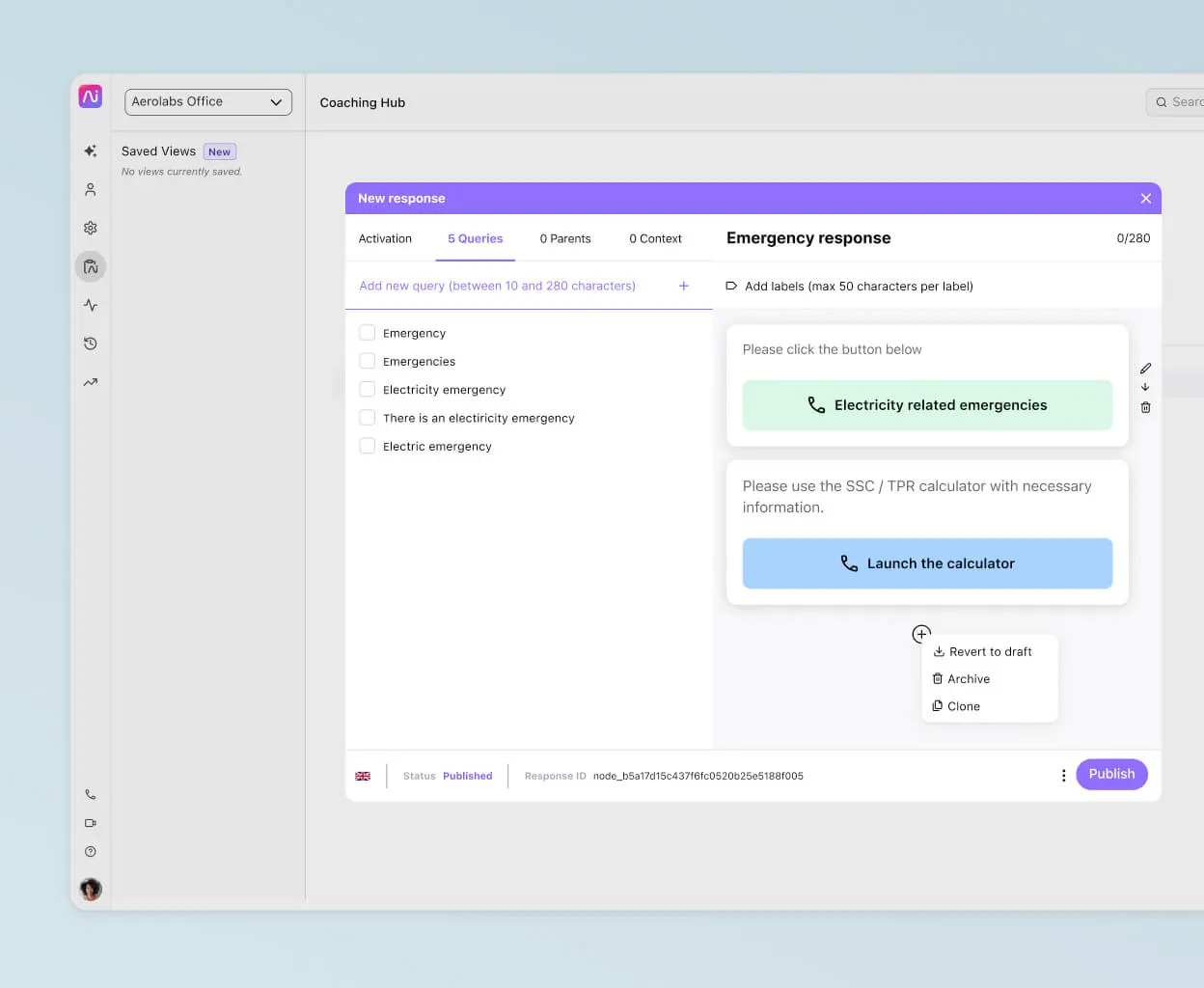How to use contact center automation to improve performance and customer service

Customer Success Engineer

Tags
Share
While contact centers are an essential part of the customer experience strategy for businesses, their operations can also be incredibly inefficient.
Agent turnover is high compared to many industries, there are a lot of manual tasks involved, and of course, customer interactions often involve a lot of back and forth.
So, how can businesses help their customer-facing teams be more productive, without investing a fortune into new systems and processes? This is where contact center automation comes in.
Keep reading to learn about what contact center automation is, how businesses are already using it to improve their operations, and what to consider when choosing automation software.
What is call center automation?
Call center automation refers to the use of technology, such as AI, to handle repetitive and time-consuming tasks in a contact center. This includes agent tasks like call routing and data entry, and also management and coaching tasks, such as QA and performance reviews.
In terms of automation tools, these can range from interactive voice response (IVR) systems to contact center AI tools like chatbots, all of which are designed to streamline operations and improve a contact center’s overall efficiency.
How contact center automation improves efficiency
Contact center automation enhances operational efficiency by streamlining various processes and minimizing manual tasks. Here are some key ways it boosts efficiency:
It saves agents time. Automation reduces the time agents spend on repetitive tasks like entering customer notes, updating CRM systems, or navigating multiple screens. By automating these administrative tasks, agents can dedicate more time to solving complex customer issues, improving overall productivity.
It decreases response times. Automation also leads to quicker responses, as self-service options such as IVR systems or AI Agents can instantly address common customer inquiries. This reduces wait times for customers and frees up agents to handle more complicated requests, which ultimately improves your service speed.
It increases sales efficiency. Sales reps benefit from automation tools too, with features like power dialers and automated lead scoring which help prioritize and streamline outreach efforts. This results in more efficient lead management, faster follow-ups, and ultimately, more conversions.
It simplifies training and onboarding. Automation can also make it easier to train and ramp up new agents. AI-powered coaching tools and real-time guidance helps new hires handle live calls with confidence, even before they’ve fully memorized scripts or processes. Automated workflows and knowledge surfacing tools also reduce the cognitive load on agents by delivering the right information at the right time—helping them get up to speed faster, with fewer mistakes.
It enhances data accuracy. Automated systems are less prone to human error, ensuring that data entered into systems is accurate and free of typos. They’re a vital way to collect a huge volume of customer interaction data—especially if you’re having hundreds or thousands of calls every day—with a high level of accuracy.
Contact center automation use cases
Now, let’s look at some practical use cases of contact center automation that can streamline operations, improve customer service, and increase agent efficiency.
1. Automated customer support with chatbots
Automation tools: Dialpad Support or Intercom
Chatbots are one of the most common automation tools for improving customer support in contact centers. By using AI Agents, you can handle routine inquiries and even tasks like checking order status, account updates, and FAQs—around the clock.
These bots can quickly respond to customers without the need for human intervention, allowing agents to focus on more complex queries. This reduces wait times and provides instant solutions for customers.
Tip: Implement chatbots on your website, mobile app, or social media channels to provide real-time support to customers, and integrate them with your CRM to ensure that chat data is captured for future reference.
2. Automated call routing
Automation tools: Dialpad Support, Genesys Cloud, or NICE CXone
Intelligent call routing allows contact centers to automatically direct customers to the best agent or department based on their questions or needs. This reduces call transfers and improves first-contact resolution, and keeps customers happy.
Tip: Use skills-based routing to make sure your most experienced and skilled agents tackle the tougher customer questions.
3. Automated data entry and CRM updates
Automation tools: Dialpad Support, Five9, AIrcall
Contact center agents often spend a significant portion of their time entering customer data into CRM systems. AI features can automate these tedious data entry tasks and ensure that all the information from a meeting or call with a customer is logged accurately and in real-time. This reduces the time agents spend on administrative tasks and ensures that data is up-to-date, allowing for a smoother workflow.
Tip: Leverage features like AI call summaries and follow-ups to automatically log the content of meetings. Ideally, your contact center platform also integrates with your CRM system and other systems to automatically update these records everywhere instead of making agents manually go into each system and copy and paste this data.
4. Automated follow-ups and reminders
Automation tools: Dialpad Support, HubSpot, or Freshdesk
On a related note, automating follow-up tasks after a customer interaction ensures that nothing slips through the cracks. If a customer’s issue is unresolved during a call, an automated system can schedule a follow-up email or call to check in on the resolution. This can also be used for sales teams to follow up with leads or customers post-purchase. For example, Dialpad AI automatically creates call summaries that include follow-up items for agents:

Tip: Set up AI or automated workflows to trigger follow-ups or reminders for both customers and agents, ensuring timely responses and customer retention.
5 contact center automation trends
Even though no one can predict where AI will take automated contact centers, it's clear that it's already dramatically changing things. Here are some key trends and advancements to be aware of.
1. Contact center automation AI
Artificial Intelligence continues to redefine the way contact centers operate, bringing automation to the forefront of customer service. In fact, Gartner predicts that agentic AI will autonomously resolve 80% of common customer service issues without human intervention by 2029.
It’s not a stretch to imagine—AI-powered tools are already handling tasks such as predictive routing, real-time agent coaching, and sentiment analysis. Over time, as machine learning improves, these AI systems will only get smarter, enabling even more proactive service and sophisticated customer interactions.
2. Omnichannel integration
Already, B2B buyers are engaging with companies across 10 channels on average, while B2C consumers typically use eight. The benefits of a unified customer experience that automatically integrates multiple communication channels into a single platform instead of making customers and agents pull information from many scattered conversations have been talked about for years.
Not only is it more cost-effective for companies to manage multiple communication and support channels from a single platform, it also impacts other areas like customer satisfaction, agent productivity, and data consistency—leading to faster resolution times, more personalized interactions, and better decision-making through unified analytics.
3. Personalization at scale
For contact centers that have to handle hundreds or thousands of inquiries every day, personalization is an especially difficult task because of the sheer volume of customers that agents have to deal with.
But personalization has huge benefits. It gives you more insights about customers' preferences and opportunities to provide tailored recommendations. And just as importantly—your customers are demanding it. According to McKinsey, 71% of consumers expect companies to deliver personalized interactions.
4. Self-service options will slowly improve
Only 14% of customer service issues are fully resolved by self-service currently, a very low percentage considering how much is being invested in this area.
With younger generations like Gen Z and Gen Alpha being comfortable with self-service for both support and sales, this is an opportunity for businesses to deploy more sophisticated conversational AI bots that can handle a wider range of queries.
5. Improved compliance adherence
According to a survey by McKinsey, respondents are more likely now than in early 2024 to say their organizations are actively managing risks related to inaccuracy, cybersecurity, and intellectual property infringement.
An underrated benefit of automated contact centers is they significantly reduce the risk of non-compliance by embedding regulatory safeguards directly into workflows. With AI-powered automation, businesses can program systems to ensure agents follow legal and industry-specific requirements during every customer interaction—whether it's a mandatory disclaimer at the beginning of a call or secure handling of customer data.
Automation tools can also monitor calls in real time, flagging compliance violations instantly and prompting corrective action before they escalate into larger issues. AI coaching assistants can give agents gentle nudges if they forget to mention a required statement or deviate from a script, all without needing constant manager oversight.
Key features to look for in call center automation tools
If you're evaluating call center automation software, here are the most important features to prioritize—especially as AI continues to transform the space:
1. AI-powered capabilities
AI is no longer a “nice to have”—it’s a must-have for automation tools.
Look for features like real-time sentiment analysis, predictive call routing, chatbots, AI coaching, and automated quality assurance. For example, Dialpad’s AI Scorecards can automate scoring and analysis by analyzing agents’ conversations and automatically suggesting if the agent has fulfilled the tasks as listed in the scorecard:

2. Ease of integration
The solution should seamlessly integrate with your existing tech stack including your CRM and other communication tools. This will help streamline operations and costs, and also make life easier for your agents and customers. For example, Dialpad Support integrates with popular CRMs like Salesforce and HubSpot to automate interaction logging and reduce manual data entry for agents:

3. Scalability
Look for software that can scale as your business grows. If your contact center is going to expand to other regions in the future, having automations in place will help your agents and coaches handle those higher conversation volumes.
4. Analytics and reporting
A good contact center automation tool should have robust conversational and voice analytics, and reporting features. Manual reporting is time-consuming and prone to human error, so look for platforms that automatically collect and analyze data from customer conversations, then surface insights through automated dashboards, alerts, and scorecards. This lets you track performance trends in real-time—without spending hours on spreadsheets.
5. Customizability
Choose a solution that is easy to customize, so you can tailor the automation features to your specific business requirements. (For example, customizable IVR menus, chatbot scripts, and reporting dashboards.)
Dialpad Support, for example, lets you quickly build a conversational bot flow using the drag-and-drop editor, no coding needed:

6. User-friendly interface
The software should be easy to use. An intuitive interface makes it easy for non-technical users to adjust flows, update chatbot logic, or monitor automated reports—which ensures your team actually uses the tool to its full potential.
7. Support and training
Something that many companies forget to check is the level of support their software provider offers—make sure you have access to comprehensive support (ideally over the phone, not just live chat) and training resources. This will help your agents and managers get up to speed quickly and resolve any issues that might pop up.
Challenges and considerations of contact center automation
To automate call center operations, it's best to have a solid plan of attack because there are several challenges that will undoubtedly come up in the process.
Assessment and planning
First, do a thorough assessment of your current contact center processes. This includes mapping out existing workflows, and identifying any repetitive tasks and pain points in customer interactions.
Initial costs
Implementing a contact center automation solution involves an initial investment that will vary depending on the complexity and scale of your solution.
Purchasing a subscription to automation software is a core part of the expense. Most solutions may offer tiered pricing based on features or usage levels. It's important to weigh these initial costs against the long-term benefits of automation, such as reduced operational expenses and improved efficiency. There are some automated call center solutions that look very inexpensive upfront, but the inefficiencies and hidden add-on costs ultimately cost more than other tools, so pay attention to the fine print in pricing plans.
Training and support, change management
To successfully implement any new technology, you need effective training and change management. Your agents need to be equipped with the skills to use new tools, especially if they involve new workflows too.
You might want to develop training programs that cover the functionality of new tools, best practices, and troubleshooting, and have a plan to address resistance to switching to a new platform.
Involve your staff in the transition process and when in doubt, over-communicate. Regular updates, feedback sessions, and incentives can go a long way in easing the adjustment period.
Maintaining the personal touch
From a customer perspective, while automation improves efficiency, it's also important not to overdo it. There are few things more aggravating to a customer than not being able to reach a person when they have an especially complicated issue or request.
To balance automation with personalized service, make sure your automation tools complement rather than replace human interaction. For example, if you have a conversational AI bot on your website, there should be an escalation option to talk to an agent (that is easy to access).
Elevate your CX with contact center automation
Forward-looking businesses are already using contact center automation to transform the way their teams manage customer interactions, and make significant improvements in efficiency, customer satisfaction, and cost savings.
If you want to learn how to implement contact center automation in your business, book a product tour of Dialpad Support to see how it works!
Want to see how Dialpad Support can work for your team of supervisors and agents?
Book a product demo to get a closer look at automations like AI Assistant, AI Live Coach Cards, and more.
